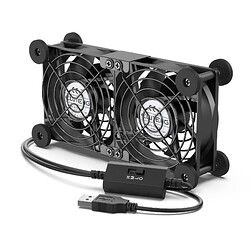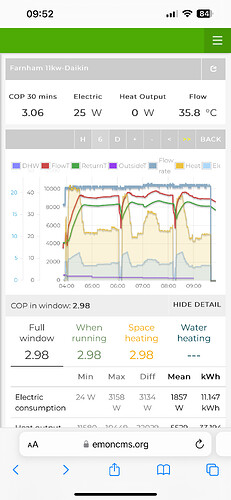if you are able to find a size of fans that are the same diameter as the distance between the bottom rail edges of the radiator, you can undermount a chain of them by fixing circular magnets into the fan’s mounting holes. I use Arctic PWM PST, they also have cabling that is designed to be daisy chained . I have 8x 90mm ones underneath a K2. controlled by an ESP32board which allows me to set my own water temperature to fan speed mapping.
Interesting - what sensor do you use for the water temp?
That’s great! Thanks. I made a chart from the data for the different flow rates: ![]()

These numbers seem to be inline with my own measurements. Hard to see how the manufacturer can claim it would double the output though when their own data doesn’t show it.
You commented in your spreadsheet that the flow rates were very low, around 0.025 - 0.05 l/sec or 1.4 - 2.9 l/min, much lower than the heat pump will run at. I think that this is because the flow is shared amongst several radiators, so the flow will be lower? (I’m guessing)
I recently bought this very cheap dual-fan unit for £18 - USB plug into smart socket, turned on and off with the heat pump. No noisier than the SpeedComforts, no idea how much air it moves.
DS18B20 wired to the same ESP32. the metal part of the DS18B20 is aligned parallel to the flow supply pipe and taped very tightly to it. this gives good enough metal-on-metal contact. the reading may be a degree or two low but you can calibrate for that. taping it to the back of the radiator works as well if you can get.
I have just had my visit from Daikin.
It was just a chat today, they need to come back to run some diagnostics for a day.
It was all very positive and she was impressed at how well the heat pump was running in a house this size and understood my issues.
We were talking about the inability of the heat pump to hold the requested flow temperature or increase it and I think we now know why.
The flow temperature decays quite often. This is because the compressor is at its minimum level and it cannot get rid of the heat produced. It cannot reduce compressor power any further so has to reduce the flow temperature to reduce the heat being produced. I don’t know how it can do this or if it is even possible, it’s a theory that needs to be proven.
The house and the heat pump are fighting each other, the heat pump wants to produce more heat than the house can take and something has to give.
Even though I have overshoot set at 4c this rarely has any effect, the heat pump generally just gradually reduces the flow temperature until the house can take more heat and then it increases again.
It works but the probable reality is the heat pump is so oversized that it is a real issue.
Hopefully their diagnostics will show in detail what is actually happening and why but this is what we think is happening.
That theory is surprising to me and seems counter to what I thought.
I thought overshoot was intended to mitigate the minimum output case. The compressor can’t go any lower, so increase the flow temperature, as house will take more of the heat if the flow temperature is higher.
Carry on raising the flow temperature until overshoot limit is reached, then cool.
This doesn’t match my understanding of how heat pump works. If the radiator circuit can’t shed the heat, then the flow temperature will go up. The compressor cannot (intentionally) reduce flow temperature without also reducing power consumption.
Heat pump raises the temperature (+dT), radiators reduces the temperature (-dT). If flow temp is decaying, that means the compressor isn’t putting in enough heat to match what’s being emitted.
It might help to play with John Cantor’s excellent Heating Simulator:
I just watched john’s video on how a heat pump works.
Maybe the fan slows down to reduce the heat produced once the compressor can go no lower?
I really don’t know though as I haven’t thought it through and I’m not sure I am even capable of doing so!
I really don’t know what is happening.
I just see the flow temperature decay, I cannot raise it unless I go extreme and the overshoot doesn’t really happen.
I thought whether to write down what we had been talking about as I know it will make me sound stupid again.
I think what we were discussing is that the heat pump is so oversized that it is causing behaviour that it unexpected, but we don’t really know.
On my smaller radiators I did used to see the overshoot working.
I don’t really see it now with the much larger radiator capacity, I just see a decay in flow temperature, generally when it is warmer than +7c outside and the heat produced is way more than the house can handle.
We also talked about the effect limiting the flow rate had on the Madoka, there was too much heat to quickly and for some reason the Madoka shut the heat pump down at only 0.5c over the set room temperature instead of the usual 1.5c over.
Hopefully we’ll find out soon what is happening, whether it is something I have done or I am doing or whether the mismatch between the house and the heat pump is just too much.
I also believe that is how it works but it is influenced by the return temperature.
As the return temperature increases the overshoot allows the flow to increase so that the heat pump can continue to run.
But my flow is dropping and the return follows keeping the dT
Maybe the problem is caused by running with radiators and a fixed dT of 8c that I rarely achieve.
I would have thought that the overshoot would allow the heat pump to increase the flow temperature to try to get to the dt of 8c but that doesn’t happen.
I have always said that I thought my heat loss was around 4kW, my previous gas usage backs this up.
We have now had a few days close to my design temperatures. At around 0c outside and 23c inside my heat loss is 3.8kW, just what I thought.
Like this the heat pump works really well.
I think the heat pump is so grossly oversized that when it is warmer outside the house and the way I run the heat pump cause the unexpected behaviour. Now I have radiators that can exploit the full output of the heat pump at low flow temperatures I just generate too much heat.
It is the only explanation I have, it’s just way too powerful for a house this size when the heat loss is less than half the heat pump’s minimum output.
I was just watching my flow temperature decay and it is because of ice, the heat output reduces.
I think the same thing happens at warmer outside temperatures but for different reasons.
I think the decay in flow temperature I see is caused by a reduction in fan speed, less air passes over the evaporator and the flow temperature reduces when the compressor is at its minimum power.
I think, for some reason, my heat pump is reducing its flow temperature by reducing fan speed. I don’t know why but I can only guess it is a reaction to not being able to deliver the heat produced.
My feeling is that the heat produced is so excessive that it does not feel that increasing flow temperature is viable and instead reduces flow temperature and therefore heat output by reducing the fan speed.
I think what you are describing Matt is similar to what I experience with my oversized Daikin (albeit the older model). It doesn’t seem able to run for more than 2 hour before it defrosts, even under milder conditions when there is no frost (confirmed visually), return temperature definitely influences the behaviour and it doesn’t do what I expect, but it’s not as pronounced as the behaviour on your system.
This morning my systems wouldn’t drop the flow rate to acheive the 7C programmed dT, it usually drops the flow rate to get close but not always. I think because the return temperature kept creeping up, so it increased temperature, which put in more heat, and now it’s shut off because the controller (old version of the madoka) has switched the system off because it’s 1.5C above target. I think switching off with a temperature of 1C outside is a pretty clear sign the pump is oversized… (installer heat loss ~9kw, mine ~7kw, actually ~4.5kw, I obviously did too go a job insulating when I refurbished ![]() )
)
@matt-drummer, apologies if you’ve covered this already - I can’t remember all the detail above! Have you enabled quiet mode?
I expected this to reduce performance, as in COP. However, all I’m observing is lower energy consumption & heat output. It’s enabled my 16kW LG to modulate down to around 750W rather than 1.5kW in normal running mode. I’ll just need to turn it off when it gets cold again.
It’s possible the Daikin is smarter than the LG and modulates down into this region automatically. The LG sadly doesn’t!
Edit - I see you have Anyone use Quiet Mode with Samsung ASHP to reduce cycling? - #4 by matt-drummer
Presumably means your unit is already using this range.
Hi Sam,
Yes, I have tried quiet mode, it made no difference to power consumption. These heat pumps have I think three stages of quiet mode available and I tried the quietest which should make the most difference.
Even a Daikin engineer suggested this in a telephone call but I don’t think he really understood the problem.
It is great that your heat pump behaves this way, it’s a neat feature to have.
I think the Daikin always goes as low as it can, I suspect the quiet mode just limits the fan speed.
Thank you for the suggestion though.
I agree, I have experimented with the quiet modes on my Daikin and all they seem seem to do is limit the maximum inverter frequency (according to ESPAltherma).
I have found that limiting the pump speed (to say 70%), not just “when sampling”, does reduce maximum power draw. But it does nothing to reduce the minimum power of around 900W
What made the heat pump stop at 19.38 and restart at 19.41?
Maybe thread resurrection but was reading back through this for any hints.
Afaik it’s oil return (Daikin do refer to it as defrost/oil return), mandatory every 6 hours (running) on my unit whatever the outside temp. Will do it even with several hours turned off as soon as it racks up 6 hours of running without a defrost.
Not sure why other manufacturers don’t seem to need it. I wonder if it’s a holdover from refrigerent splits where you may have long refridgerent runs for oil to distribute across, and maybe not needed so much for monoblocs and my hydrosplit.

